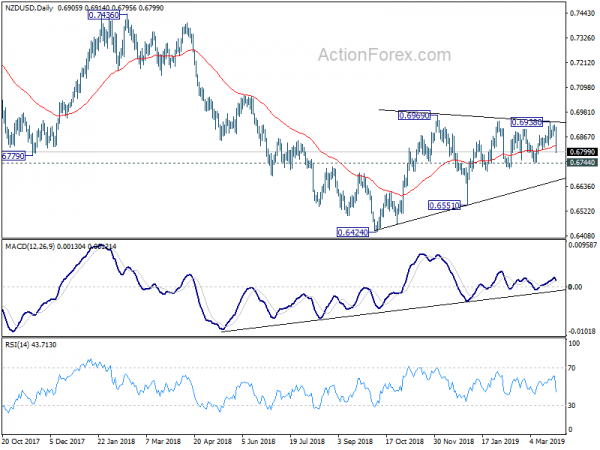New Zealand Dollar dives sharply after RBNZ kept OCR unchanged at 1.75% and shifted to a clear dovish stance. It now expected that “the more likely direction of our next OCR move is down”.
In the statement, it also noted that balance of risks to the outlook has “shifted to the downside”. At the same time, risk of a “more pronounced global downturn has increased”, and ‘low business sentiment continues to weigh on domestic spending.” Though, on the upside, “inflation could rise faster if firms pass on cost increases to prices to a greater extent.”
Markets are raising bets of an RBNZ rate cut this year, which might happen as soon as in May.
With today’s sharp fall, the first line of defense for NZD/USD is now on 0.6744 support. Break there will raise the chance that corrective pattern from 0.6424 is completed and bring deeper decline to 0.6424/6551 support zone.
Official Cash Rate Unchanged at 1.75 Percent
The Official Cash Rate (OCR) remains at 1.75 percent. Given the weaker global economic outlook and reduced momentum in domestic spending, the more likely direction of our next OCR move is down.
Employment is near its maximum sustainable level. However, core consumer price inflation remains below our 2 percent target mid-point, necessitating continued supportive monetary policy.
The global economic outlook has continued to weaken, in particular amongst some of our key trading partners including Australia, Europe, and China. This weaker outlook has prompted central banks to ease their expected monetary policy stances, placing upward pressure on the New Zealand dollar.
Domestic growth slowed in 2018, with softness in the housing market and weak business investment contributing.
We expect ongoing low interest rates, and increased government spending and investment, to support economic growth over 2019. Low interest rates, and continued employment growth, should support household spending and business investment. Government spending on infrastructure, housing, and transfer payments also supports domestic demand.
As capacity pressures build, consumer price inflation is expected to rise to around the mid-point of our target range at 2 percent.
The balance of risks to this outlook has shifted to the downside. The risk of a more pronounced global downturn has increased and low business sentiment continues to weigh on domestic spending. On the upside, inflation could rise faster if firms pass on cost increases to prices to a greater extent.
We will keep the OCR at an expansionary level for a considerable period to contribute to maximising sustainable employment, and maintaining low and stable inflation.
Meitaki, thanks.













